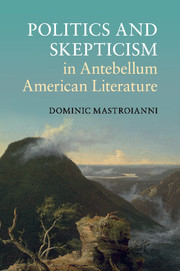Book contents
- Frontmatter
- Contents
- Acknowledgments
- Introduction: secret springs
- Chapter 1 Moods and the secret cause of revolution in Emerson
- Chapter 2 Revolutionary time and democracy’s causes in Melville’s Pierre
- Chapter 3 Hawthorne and the temperatures of secrecy
- Chapter 4 Causes of falling, Civil War, and the poetics of survival in Dickinson’s Fascicle 24
- Conclusion: antislavery writing, skepticism, and scorching words
- Notes
- Index
Conclusion: antislavery writing, skepticism, and scorching words
Published online by Cambridge University Press: 05 November 2014
- Frontmatter
- Contents
- Acknowledgments
- Introduction: secret springs
- Chapter 1 Moods and the secret cause of revolution in Emerson
- Chapter 2 Revolutionary time and democracy’s causes in Melville’s Pierre
- Chapter 3 Hawthorne and the temperatures of secrecy
- Chapter 4 Causes of falling, Civil War, and the poetics of survival in Dickinson’s Fascicle 24
- Conclusion: antislavery writing, skepticism, and scorching words
- Notes
- Index
Summary
I conclude by examining how thinking about the secret causes of mood change advances in antislavery texts by Frederick Douglass and Harriet Jacobs: writings devoted to shaping what, in the 1850s, increasingly came to be recognized as the central issue in U.S. politics. Recent work on Douglass and Jacobs tends to emphasize how their aesthetic practices intersect with their analyses of antebellum power relations understood in terms of natural rights, positive laws, and “higher law.” Debates about slavery converge with questions of skepticism both in proslavery writers’ attempts to discredit antislavery writings, and through antislavery writers’ assertions that slavery defies representation: that confronting slavery means facing realities that are not fully comprehensible. Consider the “Concluding Remarks” of Uncle Tom’s Cabin (1852), where Harriet Beecher Stowe repeatedly asserts her book’s failure to depict what slavery is. For instance, she claims to have “given only a faint shadow, a dim picture, of the anguish and despair that are, at this moment, riving thousands of hearts, shattering thousands of families” due to the slave trade. The poverty of her depictions of the feelings of the enslaved (their “anguish and despair”), she claims, is not merely a function of any authorial weakness. It is rather that literary language, and even thought in general, cannot adequately represent the “reality” of slavery: “Nothing of tragedy can be written, can be spoken, can be conceived, that equals the frightful reality of scenes daily and hourly acting on our shores.” When it comes to slavery, Stowe suggests, there must be a permanent gap between representation and reality. Moreover, by opposing the genre of “tragedy” to “the frightful reality of scenes,” Stowe implies that one can only apprehend the real events as scenes, parts of a staged drama.
- Type
- Chapter
- Information
- Politics and Skepticism in Antebellum American Literature , pp. 169 - 185Publisher: Cambridge University PressPrint publication year: 2014



